Archive for September 2019
LafargeHolcim is a “Conscientious Corporate Citizen” Everywhere But Texas

In Europe, LafargeHolcim is a multinational cement manufacturer based in Switzerland and France – two countries on the cutting edge of climate crisis planning and members of the progressive European Union. The Company portrays itself as a climate-conscientious corporate citizen, to the point of its Swiss CEO declaring the reduction of CO2 emissions as his first, most important priority.
In Midlothian Texas, LafargeHolcim runs the most conventionally dirty cement plant in Texas and is seeking a permit that could make it one of the most climate-hostile one as well. In fact, there’s some reason to believe the Holcim plant in North Texas is preparing to burn by-products from either the Canadian Tar Sands, the Permian Oil Field, or both, as fuel.
Baking rock to make cement takes a lot of heat. Regardless of how new or old a cement kiln is, regardless of the pollution controls a kiln has, every cement maker in the world still has to employ the same age-old process of applying a 2000 degree open flame to a mix of limestone and other ingredients. A third or more of the cost of running a cement plant is keeping that open flame consistently hot enough to do the job.
This is the reason cement kilns will always try to find cheap, free, even profitable sources of fuel for that flame. Hazardous and industrial wastes that c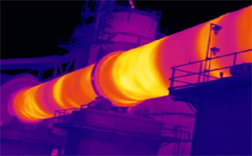 an be diverted from incinerators or landfills can be burned in cement kilns for slightly less money because they don’t have to meet the same standards. Used tires and oil. Lottery tickets. Dashboards from cars. Even municipal waste is now being burned in kilns.
an be diverted from incinerators or landfills can be burned in cement kilns for slightly less money because they don’t have to meet the same standards. Used tires and oil. Lottery tickets. Dashboards from cars. Even municipal waste is now being burned in kilns.
Burning anything causes air pollution. Burning wastes causes lots of conventional and exotic air pollution, including CO2. But just baking limestone rock also releases a lot of stored CO2. Even if there was some was to make cement without a flame, the heat needed would still release tons of CO2.
Worldwide the cement industry is estimated to be responsible for 5 to 7% of the planet’s CO2 emissions – larger then the airline industry. If the industry were a country, it would be the third largest emitter on earth, behind the United States and China.
Companies like LafargeHolcim are facing both public and financial pressures to reduce that number. In July European funds managing $2 trillion in assets called on cement companies to slash their greenhouse gas emissions, warning that a failure to do so could put their business models at risk. The mangers specifically mentioned LafargeHolcim and urged it to adopt the goal of net zero carbon emissions by 2050 and align itself with the Paris Climate Accords.
LaFarge Holcim has responded by initiating a series of technical innovations and pilot projects under the banner of “The Plant of Tomorrow” to prove its forward thinking.
Almost 300 facilities around the globe are targeted for inclusion in one or more of these “Plant of Tomorrow” projects, including a Canadian kiln installing a carbon-capture pilot project, an Ohio kiln building three wind turbines to secure its electrical needs, and kilns burning industrial waste as “low carbon” (if not low toxic) fuel.
Left out of this mix so far is Holcim’s woe-be-gone Midlothian plant. You might call it Holcim’s “Plant of Yesterday.” Despite having lots of stiff competition, Holcim not only operates the dirtiest cement plant out of the three doing business in Midlothian, but it’s the dirtiest in the entire state.
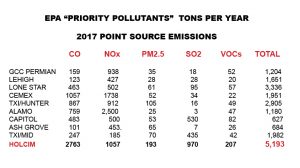
Holcim’s Midlothian plant is the largest Carbon Monoxide (CO) polluter among all 10 Texas cement plants – a sign of poor combustion. It’s the second largest Nitrogen Oxide (NOx) polluter among the bunch, emitting almost twice as much smog pollution as the other two Midlothian cement plants combined. It’s the largest PM 2.5 (Particulate Matter) polluter by far – almost 100 tons a year separate it from second place. It’s the largest Sulfur Dioxide (SO2) polluter by a large margin and releases four times as much Volatile Organic Compounds (VOCs) than the next highest plant. Almost all 2017 pollution numbers for Holcim have gone up over the last five years. A plant that was already bad is getting worse.
Now add Holcim’s request for a new permit to burn 100% Petroleum Coke in one of its two kilns.
Pet Coke is a byproduct of oil refining. It’s a concentrated carbon solid residue that is left behind after the refining process has converted the bulk of the oil into liquid fuels such as gasoline and diesel.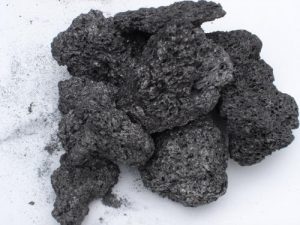
Pet Coke is like coal, but dirtier. Pet Coke looks and acts like coal, but it has even higher carbon emissions than coal. On a per-unit of energy basis Pet Coke emits 5 to 10 percent more carbon dioxide than coal. A ton of Pet Coke yields on average 53.6 percent more co2 than a ton of coal.
As well as significantly higher co2 emissions, Pet Coke also has high sulfur and toxic metals content than coal.
Because its a waste product, Pet Coke is cheap for Holcim to buy or it could even be free if a refinery wanted to get rid of its supply. And now, thanks to the exploitation of the Tar Sands and the oil boom in the Permian the US has lots and lots of Pet Coke. The heavy oil refining capacity in America is now the largest in the world, with over 40 percent of the global market. Much of that production takes place on the Texas Gulf Coast in huge new expanded refinery complexes like Motiva and Total in Port Arthur. The capacity to produce Pet Coke in U.S. refineries has doubled since 1999. In fact, the annual production of Pet Coke is so large these days, it’s outstripped most of the usual uses for it and is “priced to move.”
Because Holcim wants to burn 100% Pet Coke, and it must have a reliable source to burn it 24/7, there’s reason to believe the company has signed a sweetheart deal with one or more refineries to supply it. Probably from the Gulf Coast, and probably from one of the refineries dealing in Canadian Tar Sands oil or Permian Basin product. Both are poster boys for irresponsible fossil fuel development with the Tar Sands and the Keystone Pipeline igniting modern Climate Crisis activism and the Permian becoming one the planet’s largest sources of Methane as tons of unused natural gas are burned off from thousands of rigs.
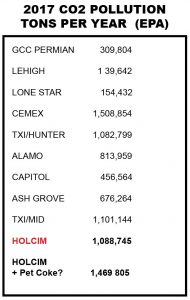 Currently, Holcim is “only” the third largest CO2 polluter among all ten cement plants in Texas, and fourth among all of Holcim’s U.S. plants. But burning 100% Pet Coke in its Kiln #2 could change that rapidly by adding a whopping 400,000 tons more of CO2 to its annual totals. That would send it to #2 in Texas and #2 in the entire US Holcim fleet of cement plants. Not very climate conscientious. And probably not a number you want to tout in trying to sell your “Plant of Tomorrow.”
Currently, Holcim is “only” the third largest CO2 polluter among all ten cement plants in Texas, and fourth among all of Holcim’s U.S. plants. But burning 100% Pet Coke in its Kiln #2 could change that rapidly by adding a whopping 400,000 tons more of CO2 to its annual totals. That would send it to #2 in Texas and #2 in the entire US Holcim fleet of cement plants. Not very climate conscientious. And probably not a number you want to tout in trying to sell your “Plant of Tomorrow.”
At the same time Holcim is trying to project an image of a concerned 21st Century corporate entity to the rest of the world, it’s doing business in Texas like its still 1999.
Officially, the State of Texas doesn’t care about CO2 pollution. Heck, officially it doesn’t even believe there’s a climate crisis. There is no regulatory system for controlling its releases and only the EPA bothers to track CO2 releases at all. So this increase in planet-melting pollution will go completely unaddressed in the permit proceedings themselves.
Also officially, despite the evidence, the State and Holcim both say no other kinds of pollution will increase when 100% Pet Coke is burned at Holcim. No increase in PM 2. 5. No increase in SO2. No increase in metals. Citizens don’t believe them. A group calling itself “Midlothian Breathes” has formed to fight the new permit and has already caught regulators off guard asking tough questions about new emissions.
But trying to get the State of Texas to do the right thing about air pollution is an uphill fight. Instead, perhaps citizens should take these embarrassing numbers directly to LafargeHolcim, who’s claims of new fund corporate responsibility are belied by them. Contrasting its Texas operations with those of the rest of its facilities may be a way to shame the company in its own European backyard. Officially the company may still be able to be embarrassed. Texas state government left that possibility behind years ago.
DFW Smog Gets Worse for First Time Since 2015. Government: ¯\_(ツ)_/¯

2019’s “ozone season” came in like a lamb but is headed out as big, wheezy lion.
A three-day stretch from Thursday September 5th to Saturday the 7th that combined triple digit temperatures with lots of air pollution was enough to push Dallas-Fort Worth smog numbers for the year over 2018’s annual average. It was the first year-to-year increase in ozone levels since 2015, and more than enough to insure DFW will be in violation of the Clean Air Act for the 28th year in a row.
Because the formula for arriving at these averages is so convoluted, discounts the highest three numbers, and is stretched out over 8-hour periods, it takes a lot ozone to make them go up even incrementally. Raising the annual average by even one part per billion (ppb), from 76 to 77, as occurred by Saturday evening, hides a lot of Really Bad Air. Smog levels were in the 90’s and even close to 100 parts per billion at monitoring sites in the northern part of the Metromess. EPA’s national standard for 8-hour exposure to ozone is a 70 ppb average.
Three sites saw their 2019 highs set during this 72 hour period. Frisco had an eight hour average of 88ppb on Saturday, Keller 84 ppb and North Dallas 83ppb. There were four hours on the afternoon of the 6th when smog was over 90 ppb in Frisco.

That’s reminiscent of the bad ‘ol days from the Turn of the Century when levels in the upper 90’s and even topping 100 ppb were routine. Since 2000, there’s been a more or less steady fall in smog in DFW thanks to better controls on combustion-powered vehicles, and the citizen-induced decreases in pollution from Midlothian cement plants and the retiring of East Texas coal-fired power plants. In 2000 DFW’s annual ozone average was 102 ppb. It’s taken 20 years to lower that number to the high-to-mid 70’s. For the last three years we’ve seen decreases of 3, 1 and 3 ppb. 2019 halts that downward trend.
Beside the human health toll these numbers represent – an increase in asthma attacks, ER visits, strokes and heart attacks. – they also represent a challenge to government. This increase comes as the usual planning process to reduce dirty air in DFW sits in tatters. In fact, there really is no process anymore.
In the past, the North Central Texas Council of Governments (NTCOG) would bring the Chambers of Commerce, elected officials and some environmentalists together to cobble out a list of proposed strategies to reduce smog, then submit it to the Texas Commission on Environmental Quality in Austin where it would get watered down by corporate lobbying. Nevertheless, those past plans did have an influence on tightening emissions for ancient cement kilns and other industrial sources and they can take some credit for the two-decade decrease in smog.
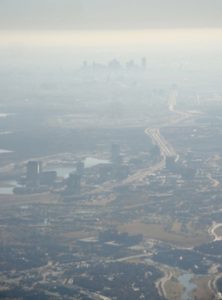
But that process hasn’t taken place since even before the current administration took office. The last plan submitted by the region to the state was in 2013. Because Austin kept ignoring most of the region’s recommendations, NTCOG just gave up trying after that. It’s Clean Air Steering Committee was disbanded and hasn’t met for six years now. Despite approaching our fourth decade of illegally bad air there’s no official body in DFW working on a regional clean air plan. Everything is being run by Greg Abbott’s state agency – one that doesn’t believe there’s a climate crisis, wants to increase permissible exposure for dangerous pollutants, and whose former Toxicologist in now leading the Trump administration’s efforts to roll back federal pollution standards.
It’s doubtful a single part per billion rise in the regional average will prompt reconsideration of this laissez-faire approach. But it should.
Before the 2016 election, Downwinders was trying to pave a path for the federal government to take away the power of Austin to determine DFW’s clean air progress. We had hoped to have EPA delegated as the “final cut” author of a new clean air plan. Trump’s election made that impossible. But should this administration be gone by 2021, that strategy is still one local residents would be wise to pursue. As long as the State’s environmental agency is in the hands of anti-science flunkies and fanatics, there will be no concern about DFW smog in Austin.
